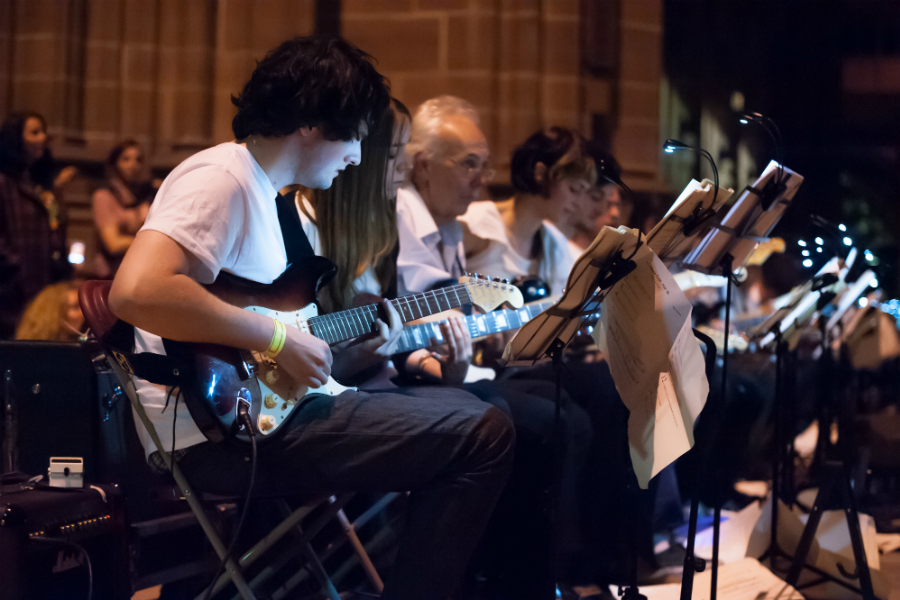Give It Everything You’ve Got

Responding to yesterday’s massive funding cuts, and ahead of the International Festival of Business 2014, Laura Brown argues that we need a whole new approach to arts giving in Liverpool, otherwise we risk losing our next generation of cultural instigators…
We need a radical new strategy for arts giving in Liverpool. Major arts organisations, businesses, all of us — right down to the grassroots and freelance curators — need to hammer something out because otherwise the ride stops here.
Liverpool works hard and it plays hard. From its start-ups to its multi-nationals, to its orchestras and cutting edge cultural institutions, this is a city that is driven by creativity, by innovation and commitment to creating, not just cold hard cash, but a better place to live and be. Unfortunately, Liverpool is also a city where it’s really hard to get to the top table. There’s a network of clued-in figures across business and the arts who have great relationships. Not part of that? Good luck!
Perspective is everything, as is experience. But we need to bat the past into the long grass and start working together to fundamentally reassess donation, patronage, arts funding and giving. If we don’t we are screwed. Properly screwed. The worst case scenario is not losing major arts organisations; the worst case scenario is having no young artists, curators, musicians and people who think they can make a difference. That has to be our goal.
Without a systematic shift in how we look at funding, how we relate big business and big arts, there will be no Jayne Caseys, no Eddie Bergs, no Pete Wylies. There will be no independent Liverpool. Instead, we’ll be a stop-off on the international calendar, an outpost of national cultural experience. Unless we make art fairer, and enable smaller organisations and individuals to get access to the serious funding and philanthropy conversation, then grassroots community art will dissolve. Without it Liverpool will be, quite frankly, as dull as the ditchwater it sprang out of 800 years ago.
Whether you believe the local or national government spin (and it comes from both sides equally vehemently), Liverpool’s arts and cultural institutions face a huge cut in their funding over the next three years. We could not only lose a major organisation, but remove the ability of all but the very wealthiest to enjoy a life and career in the arts. For it to survive everyone understands there needs to be a concerted effort to reassess and restructure how we define philanthropy and how we fund projects, initiatives and organisations, and how we ask for money.
Yesterday, Liverpool City Council announced enormous cuts to adult care, libraries and leisure centres. We saw this coming. Just a few months ago, Liverpool Council launched an online budget simulator which invited people to try to balance the books. It was a hamfisted but effective way of telling you that it’s bloody hard to bridge a £156m shortfall. Out of sheer curiosity, I made a 50% cut to its culture, sport and leisure budget, and that (eerily) forecast the closure of all community libraries, closure of more sports facilities, limited public access, and redundancy of staff.
My budget simulator also predicted the closure of one of Liverpool’s halls (like St George’s Hall), parklands sold, the loss of every major cultural organisation and festival, the closure of all grant-funded organisations, and mass redundancies. The knock-on effect of this, of course, would mean the exodus of creative talent, the loss of 9m potential visitors, a £30m loss to the city’s economy, no outreach or education programmes, a severely diminished ability to receive visitors, and an inability for the city to retain graduates.
Find your money elsewhere, kids, because this show is over. And who would want to live somewhere with little or no cultural life?
It’s a deliberately bleak picture, but the truth is that the city’s major arts organisations will indeed take a hit. But, those art spaces in Liverpool – call them Liverpool Arts Regeneration Consortium (LARC), Visual Arts in Liverpool (VAiL), the Big Eight, whatever – all have excellent mechanisms for interacting with and developing partnerships between themselves and the city’s commercial industries and securing different modes of income. This philanthropy cannot plug the whole of the gap left by the loss of local authority funding, but it helps.
£1000 to the Everyman secures the chance to name a seat in the new theatre, an invitation for two to the opening party and a limited edition print of the new building. Both FACT and Tate Liverpool have membership schemes; all the better to be able to plan for an expected level of income. Tate’s corporate sponsorship promises a return on investment. Citing its BP case study, the oil giant seeks to “connect people and inspire creativity, reach a broad and international audience, promote understanding and enjoyment of art to wide reaching audience, engage with clients through exclusive entertaining and to engage (its) employees in their arts and culture programme”. With dedicated staff, strategy and confidence, this major arts organisation is best placed to delve into the corporate world and come out with a bob or two in its pockets.

Yet what about the smaller arts organisations, grass roots projects and independents? The loss of a major arts organisation would certainly hit the headlines in the Liverpool Echo (it might even bump a crime story to page 3), but the loss of 50 smaller ones? More importantly, what about the inspiring creative individuals, the young people who never quite got a foothold but knew this was their passion? What about bands forced to split up because they can’t afford to travel to gigs; artists downing tools because they are too tired to paint while they work one or more jobs; venues sitting empty because business rates are too expensive or the developers have moved in; or the creative individuals dissuaded from higher education by tuition fees?
LARC’s motivation to “promote a culture of creativity, innovation, learning and ideas across all aspects of Liverpool life” is a vital and laudable one. But these are seven organisations with an existing profile and authority. Without a fundamental shift to inspire a boom in philanthropy that helps every layer of this city’s creative community, from teenagers to freelance curators, then there will be no scene to be heard.
This is not to say there is no provision within Liverpool’s arts organisation for young people. Each has dedicated programmes. FACT’s Young Liverpool Film Night is a delight. Art students in Merseyside universities get free entry into the launch night of many major exhibitions. The International Youth Arts and Cultural Festivals, organised by LARC for Summer 2014, will inevitably be great and enthusing for all those who take part.
But let’s be perfectly frank. When you’re 13, you want to believe you can change the world on your own, with your own mates and your own guitar, or paintbrush, or words or ideas. As you should. We shouldn’t just create a young-person-friendly imitation of a grown-up art world and say that’s what we’re doing to encourage young people. Art and culture develops when a gang of you sit in a room and start bouncing around ideas. It comes from what you see and experience. It comes from growing up in a scene that’s emerging on your favourite street in the city. That’s independence. And that’s where it gets exciting.
The problem is that supporting individuals or grass roots arts organisations might not give the profile boost that a business wants. And businesses need to stop thinking like that. Giving shouldn’t be seen as getting something tangible in return; it isn’t about a press release or a photo opp. It isn’t, or shouldn’t be, just about getting a special seat in the theatre. Instead it should be about creating a landscape that echoes the one you had access too; when it wasn’t vastly expensive to travel around the country to play a gig or see an exhibition, when you could access the top tiers just by knocking on doors. The city many of us grew up in was much more egalitarian, much more politicised and much more vibrant. That’s because we could explore for ourselves what we wanted to do and much of it was free or at the least very, very cheap.
Business in Liverpool anticipates a glorious year with the arrival of the International Festival of Business 2014 in June. It would be a travesty if while the corporate side of the city reaches its epoch, its cultural community loses heart and slowly vanishes. Instead of being seen as a profile raiser, philanthropy should be part and parcel of a way of sharing experience, expertise and knowledge. Both business and art can learn from each other. Philanthropy should be an exchange rather than a one way street. And its motivation should be civic pride, responsibility and social inclusion.
How about funding a musician who needs to travel to gigs? Have you ever had to travel by bus with a cello? It is not fun. If you’ve lost your funding to go to college, then how about a local business supporting you? What about travelling to see exhibitions around the country, to learn how to be a curator and immerse yourself in cultural life and identity; could a firm of solicitors or haulage company not support that? How can we create those partnerships and that kind of access?
Since 2007-8 business contributions to the arts in the UK have dropped by 30%. To give an indication how vital that support is, it represents two fifths of all arts support. Sponsorship is strong at £113.8m, but in-kind support has fallen. This in-kind support, like promotion, marketing and event management, represent the skills many smaller arts organisations, individuals and young people simply don’t have access to. If no one knows about them or the work they do, they will simply close. The biggest decline has been in business donation; business investment in the north-west is £8m.
It needs to be higher. And it needs to be the kind of support that filters down from major arts organisations like Tate Liverpool to smaller ones and individual artists. And it needs to be more than money. It needs to be contacts and experience and support.
The arts, right the way from the bottom-up, needs to get better at asking for money and investment, not just for itself, but for the organisations and individuals around it as well. It isn’t about the arts behaving as a business, or business behaving more like the arts; instead it is as London International Festival of Theatre’s (LIFT) Julie Rowntree describes it: as walking in to work on the other side of the street to see a fresh perspective (see Changing the Performance: A Companion Guide to Arts, Business and Civic Engagement).
Corporate giving and sponsorship needs to be about more than a Corporate Social Responsibility programme. It needs to reflect a passion and determination to protect a city. If Liverpool’s arts and cultural community becomes barred from its poorer or working class, if it becomes too expensive to enjoy or to participate in, then it isn’t just the city that will be harmed. There is value in a robust and healthy cultural identity, but to ensure this continues there needs to be a working and sustainable relationship that bridges Church Street and removes the barriers between culture and business. Business needs to get involved. Larger arts organisation need to make room for their smaller colleagues.
As a friend put it this week, it’s really hard to be creative when you’re hungry and skint. Let’s buy each other lunch.
Laura Brown
Read more — IFB 2014: What’s In It For Me?
Images courtesy Rhys Chatham, A Crimson Grail (Liverpool Biennial and Andrew Ellis); Freehand at FACT; Tate Young Persons Collective





